
Return to home page
Read March 2007 blog Read February 2007 blog Read January 2007 blog Read December 2006 blog
Go to my 2001-2 Australia travel book
Send a comment
Other blogs I'm reading: Christine Allen's // Gordon Price's // Sarah Jane's photo site
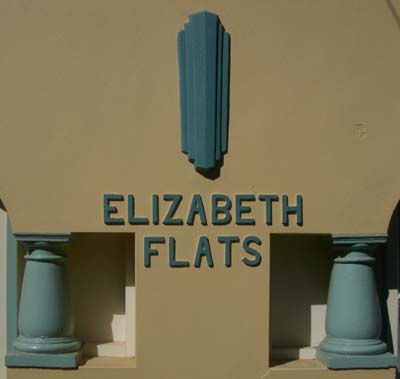 |
Our
new home is the Elizabeth Flats, a 1936 art deco triplex in Katoomba,
the largest town in the Blue Mountains west of Sydney. The address is Flat 1, 21 Warialda Street, Katoomba, NSW Australia 2780. There is a separate web page with more pictures of our new home and its surroundings. |
| April 29, 2007: The
Australian Labour Party has been holding its convention, with its new
leader, Kevin Rudd, well ahead in the polls and looking to be the next
PM as of the (southern) Spring election. The platform is mainstream and
cautious and he will probably prevail, if only because the electorate
is panting for change after the Chrétien-like tenure of John
Howard. If Rudd does win, all of Australia will be Labour, as all the
states have Labour governments. A minor part of the convention, and a major difference with Canada (one of the themes of this blog recently, it seems), is Labour's attitude to same-sex couples. Labour is the left-wing, after all, if you discount the increasingly marginalized Greens. The new Labour policy will provide legislative protection for same-sex couples, but it is not about recognizing gay marriage, or even civil unions, according to a Labour spokesman. And a union boss said that the proposed changes "would hurt Labour's credentials with ordinary Australians." And furthermore, Labour heavyweights including former NSW premier Bob Carr welcomed a proposal that "would dissuade [the party] from adopting a charter of rights." How different is that? Meanwhile, the Lazarus-like PM has launched a major intiative on nuclear energy. Australia is the second-largest exporter of nuclear fuel in the world (after Canada), and Howard has seized on nuclear energy as a way of mitigating climate change while responding to increased energy demand. Not surprisingly, the Labour party is deeply split on the issue even of expanding the mining of uranium, let alone generating power from it. 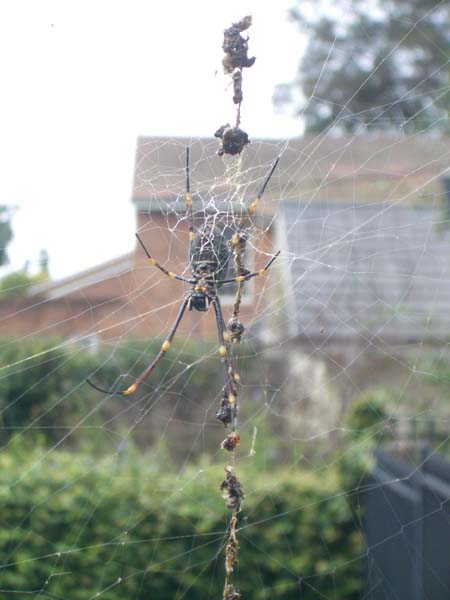 This spider, probably harmless to people but nevertheless the size of a hand, has been living in sister-in-law Caroline's garden in Sydney for months. With its victims wrapped up and hung from its web, it reminded me a bit of Prime Minister John Howard, who could yet win another election with the brilliant strategy that has kept him in power for more than a decade. But enough serious stuff. On the ABC, master-satirist John Clarke has turned his sights on Kevin Rudd, picking up on Rudd's habit of asking and answering his own questions when confronted with a switched-on microphone. Fans of John Clarke, like us, will remember him and his partner Brian Dawe for a brilliant spoof of the organizing committee of the 2000 Sydney Olympics called "The Games." It ran by the seat of its pants, responding hilariously to the events leading up to the staging of the Olympics, and gained a huge audience. On one episode, when the Prime Minister had refused to bow to IOC pressure and apologize to the Aborigines for broken promises etc. etc., "The Games" hired an actor, a man actually named John Howard, to read out a formal apology to the world. Clarke, in character as the CEO, said: "Nobody knows what John Howard looks like anyway." Reportedly, pubsful of people stood and cheered. The Knowledge Network in BC picked it up and ran it, which is how we knew about it. Perhaps it's available in a video store somewhere in Vancouver? And why is there no parallel, such as a free-form spoof of VANOC on TV? Some things get done really well down here. |
| April 27, 2007: It
was interesting to see the aged Malcolm Fraser on TV last night; he was
the Liberal (i.e. conservative) prime minister in the 1970s. It was the
10th anniversary of a government report on the "Stolen Generation" --
the aborigines who had been taken from their parents to be lodged and
reprogrammed in residential schools. Nothing had been done since, he
said, and he declared that Australia should follow Canada's lead in
establishing a compensation fund and apologizing to all the indigenous
former children who had been affected. There was a brief shot of a
Nishga'a ceremony in BC, which I must say gave me a brief pang of
homesickness. The other time Canada made the news here recently was the commemoration of Vimy 90 years ago, and its juxtaposition with the deaths of Canadian soldiers in Afghanistan. It is on my mind because Wednesday the 25th, two days ago, was ANZAC Day, the most sacred day on the Australian calendar. On the 25th of April, 1915, soldiers of the Australia-New Zealand Army Corps stormed the beaches at Gallipoli and, over the ensuing 8 months during which of them 8,000 died, tried fruitlessly to dislodge the Turks from the heights above. Their effort, their recklessness and their comradeship helped create the ANZAC legend, as did the incompetence of their British commanders (overseen by Winston Churchill, who has a very very small fan club here). The ANZACs went on to further defeats on the Western Front until the spring and summer of 1918, when significant victories at Villers-Bretonneux, Hamel and Mont St. Quentin gave them glory. Later (this is a brief history), they were the Rats of Tobruk, then fought in New Guinea in the Second World War on the almost-mythic Kokoda Trail, and in Korea. Australia sent troops to Vietnam, reflecting the critical military alliance it has had since 1942 with the USA. "All the Way with LBJ" was the slogan of the Menzies government in the '60s, when there was a draft in Australia and no convenient neighbour like Canada to escape to. And it is part of the "coalition of the willing" in Iraq, which is very controversial -- the Labour Party is promising to bring the troops home promptly if it wins the upcoming federal election. ANZAC Day is very solemn, with dawn services, followed by a march at 11 am. People tend to wear sprigs of lavender, poppies being the symbol for the much smaller Remembrance Day ceremonies on November 11. As there is only one WWI vet left alive, aged 108, the ANZACs of that war are represented by a riderless horse. On the TV, the march in Sydney looked almost like Vancouver's November 11th one, as it was raining. Australia is rather a martial, scrappy country, more like the USA than Canada or northern Europe. So I have always found it curious the way that the defeat at Gallipoli became so much a part of their military culture, and how the mateship and hatred of (British) authority became part of the wider one. The derogatory word Pom, for an Englishman, emerged in the '20s in the wake of the war. If there's a military culture in Canada, it's reflected in the victory at Vimy in 1917, rather than in the 1942 disaster at Dieppe; if you travelled in Holland as I did 35 years ago, a maple leaf on your bag was the assurance of greetings/offers of hospitality and so on, as the Canadian army was the liberating force there. Christine and I considered going to Gallipoli when we were in Turkey in 2006, but the 6 hour bus ride from Istanbul was daunting. It just seemed to be from too long ago (yet we went to Ephesus, a city from very long ago, so go figure). All is curious, how two countries of British parentage became so different. Call it large geography, small population, and the twists of fate. |
| April 22, 2007: The
drought is back in the national news again, as farmers in the
Murray-Darling basin, the huge river system that drains much of
eastern-central Australia, have been told that they'll get no
irrigation allocations unless there is heavy rain in the next 6 weeks
or so. The drought hasn't been much in the news for the past couple of
months, at least in coastal New South Wales, because we had buckets of
rain in February and March, as they had in northern Queensland.
Fire-danger levels have been low in the Blue Mountains and the dam
levels for Sydney went up. In fact, the portion of NSW classified as
being in drought dropped from 92% or so down into the high 70s.
However, little is being done on serious infrastructure development or
water conservation anywhere in the country; by one estimate, 97% of the
rain that hits Sydney flows directly into the ocean as almost no one
has water tanks attached to their houses. The news came with the dire warning that crop yields will drop so low that Australia might have to import food for the first time, it seems, since the beginning of the Sydney Cove convict settlement 210 years ago. Even worse from my point of view, wine prices will go up as the "billion-litre lake of plonk" is drained and the new crops are much smaller. It's interesting the way everything turns into a stoush (i.e. a fight): New Zealand, which has had normal rainfall, is more than willing to export food to Australia, but warns that if Australia continues to use its quarantine regulations as a trade barrier it will sell elsewhere. But it looks like even the drought will be overshadowed by the stoush about workers' rights in the run-up to the Spring (i.e. southern Spring) election. Australia is still a workers' paradise, or at least a union paradise, compared even with the heavily unionized British Columbia of a generation ago. The prime minister, John Howard, and his Coalition party have pushed through AWAs, as I mentioned several days ago -- the Australian Workplace Agreements that allow for dismissals and erode workers' generous statutory benefits, all in the name of modernizing the economy and improving productivity. The Labour opposition leader, Kevin Rudd, is making a firm move to occupy the political centre, and has just won a victory of sorts over the head of the Oz union movement by confirming that he will demand secret ballots for any strike vote. The union leadership was trying to claim that this would lead to an erosion of workers' rights. A strike vote without a secret ballot? That went out in Canada in the '50s, as I recall. Rudd was quoted to the effect that the union leaders had to come to terms with the 21st century. Conservative newspapers and business groups have already branded the union-Labour dispute as an orchestrated bit of puff to enhance Labour's reputation. And, on the subject of labour relations, a different type of restaurant review from our local paper, the Blue Mountains Gazette. The Star of India is on the highway in Katoomba: 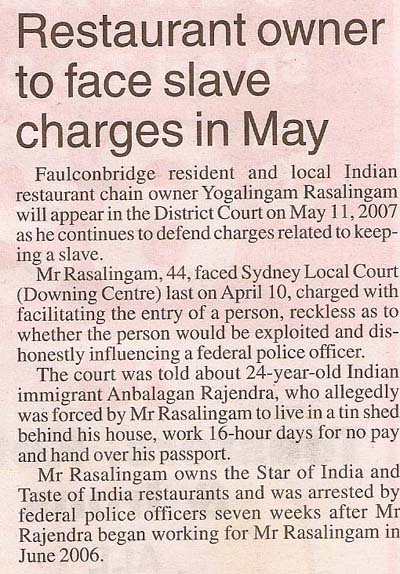 |
April 20, 2007: A
timely billboard on an overpass on the M4 in western Sydney.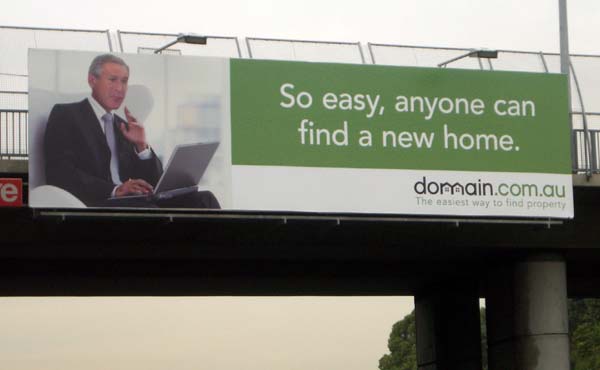 |
April 18, 2007:
In my April 14 rant about restaurant service, I neglected to mention
"the water top-up." In Australia, needless to say, you fill your own
water
glass, which is excellent. In Vancouver, the sub-sub-busboy-with
piercings-and-Hep-C comes to your table, picks up your water glass by
the rim with his hand (who knows where it's
been?), fills it, and puts it back on the table. Now how much disease
can be transmitted by that? Depth perception can go a bit wonky for
some of more stoned-looking ones, so the "table pour" is risky. In flu
season I used to become almost aggressively protective of my glass in
restaurants.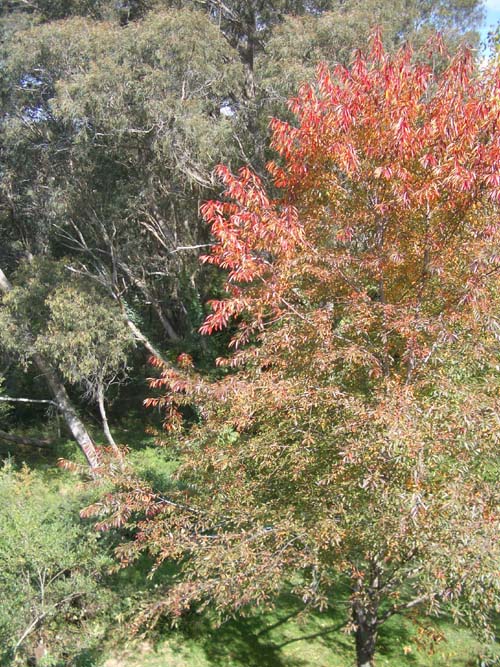 Meanwhile all is
calm, all is
bright. The photo above from the Flat 1 (upstairs) sun room/dining room
shows the "bird cherry" in the backyard turning really beautifully into
autumn russets, with the backdrop of unchanging olive-green eucalypts.
Bird cherries are one of the exotic weed-trees of the Mountains. A few
months ago I posted a photo of crimson rozellas eating the cherries,
whose seeds they then proceeded to poop throughout the bush, no doubt.
As it's illegal to cut down a tree here without a permit, we had
resolved to worry away at it with trained beavers, reducing it
gradually to a point that we could make it disappear -- presto! --
without anyone noticing. Lacking access to beavers, I purchased a small
electric chain saw and got rid of 2 of the 3 trunks, then lopped some
of the lower branches. Now it doesn't look so huge, and it is pretty, so it
will stay at least until Christine develops a plan for what might
replace it.
Calm at least in terms of weather, but we've run into a bureaucratic snafu with one of the privatised utility monopolies. When the woman at the call centre told Christine that "we must respect our protocols" I thought Christine was going to scream. Everything here is done with call centres, there are no longer the sort of storefronts with helpful humans on the main streets of towns (except for Sydney Water, the public utility), and the call-centre staffs are invariably polite, helpful if your request fits into their "protocols," and utterly obtuse and infuriating otherwise. At the end of the conversation, the call-centre human uttered what has become the standard Aussie banality for everything, including okay, thanks and goodbye -- "nao wurries" -- to which Christine shot back, "What do you mean 'no worries'? No worries for you, maybe!", and hung up. Our "issue" with them will eventually be resolved, we chant repeatedly. Given that Australians have a "larrikin" image -- rugged, no-nonsense individualists -- it is amazing how much bureaucracy they tolerate. The worst culprit in our experience is the RTA -- the Roads and Transport Authority -- the New South Wales equivalent of the Motor Vehicle Branch (auto insurance here is private, by the way). An acquaintance had a run-in with the RTA because she is called by the second of her given names, and they demanded that registration documents be redone with her first, unused name. But this was nothing compared with the episode reported in the paper, where the RTA demanded that anyone who had a handicapped-parking pass produce proof every 3 years that they still were handicapped. Obviously, the RTA was responding to a lot of misuse of the passes, but they put in a rule with no exceptions, the classic bureaucratic shelter. Thus, when a double amputee was forced to produce proof that her legs hadn't grown back, it made the papers. The woman in question offered to stab knitting needles into her artificial limbs in front of the RTA staff, but they insisted she needed a doctor's certificate. "It's the same rule for everyone," they reportedly chorused. Egalitarianism, Aussie style. From a neighbour we heard another story that fit the mold. A teenage girl got a part-time, after-school job shelving books at a branch library in Sydney. Because it technically was a public-service position, she needed to get a medical certificate which required a special form that could only be faxed from the employer to a designated doctor, then filled out at the time, which caused a cancelled appointment when the employer forgot to fax the form. All eventually went well there, but then it turned out she also need a police check. "You are aware that she is a 16-year-old schoolgirl," her mother asked the employer. "Same rule for everyone -- sorry!" she was told. The issue of bureaucracy, work rules and worker protection looks to be one of the big issues in the upcoming federal election. The Howard government, which is pro-free market, has introduced AWA's -- Australian Workplace Agreements -- to simplify hiring and firing and, it argues, improve productivity in the workforce, get rid of deadwood and so on. Historically, Australia was notorious for its featherbedded union agreements, especially in the railways (which were themselves notoriously slow to change: for much of a century, the states had different track gauges; State Rail in NSW recently received international recognition for having the highest rate of subsidy per passenger in the Asia-Pacific, thus the lowest efficiency). The Labour Party is promising to modify the AWA legislation to ensure that workers still have a "fair go." Defending the government side is the minister of industry and employment, a bloke about the size of a tree trunk with, to a Canadian, a name that would guarantee him political success: Joe Hockey. Stay tuned. And the routed NSW Liberal leader, Peter Debnam, has been replaced by Barry O'Farrell, who always said that he would run for the leadership once he lost 25 kg. His nickname from his weightier time in politics? Fatty O'Barrel. |
| April 14, 2007: La
Christina and I walked up to a restaurant called Mes Amis yesterday
evening, carrying our bottle of wine (almost everywhere's BYO). It was
a very nice place, with adventurous food, a cut well above our usual
fare of Thai, pizza, take-away Indian or charcoal chook, with a level
of service above
average, too. But was the service good,
in a North American sense? We discussed it, and I wouldn't be surprised
if she writes something on her blog,
too. Australian waiting-type humans are well-paid and the idea of tipping has never caught on. People "round up," or leave a dollar or two perhaps, but often you won't leave anything. So there's little incentive for the staff to really serve you. The food is brought, wine glasses provided, and although there is some "water-induced deafness" you can usually get a bottle of tap water without too much trouble. To me, this is a mixed blessing, because I loathe the Vancouver experience, where the waiter is always hovering, jumping in to top up a wine glass after each sip, butting into conversations to ask, "Is everything to your satisfaction?" grovel grovel, which reminds me of the one time we went to the famous Bishop's restaurant on 4th. "Would you like another bottle of wine ... [accompanied by obsequious hand-wringing motions]?" To the point where I've said, don't touch the wine bottle again, please, or you won't get a tip. But here it's all a bit too caj (pronounced as the first syllable of "casual"), perhaps. Why weren't the old waiters at Café de Paris, like Jean and Jacques, cloned and sent out to teach the world what service is all about? I wrote on April 7 how we'd gone to Sydney to see the Archibald and other prize entries at the art gallery, but didn't mention the immense, Stalinist size of many of the portraits. If you can't paint well, paint big -- that seemed to be the rationale. It's one of the weirdnesses of the modern art world: there are more and more paintings to be shown, but there's also a tremendous push to paint on a monumental scale, which reduces the number that can be shown. The Australian's art critic, who's a rather supercilious bastard most of the time, wrote an article talking about the mechanics of the Archibald Prize. More than 600 entries, with about 3 1/2 hours for the jury to review them and make the selections, which amounted to about 20 seconds per work. Which means that they're as good at reading signatures as some pseudo wine connoisseurs are at reading labels. And only about 40 of the pictures could be hung, mainly because many of them are wildly over lifesize. Four by six feet seemed about average. Rant rant rant. Anyway, this explains why the Salon des Réfusés at another Sydney gallery is attracting so much attention. If we can coordinate our interface with the tradesmen here, we'll get into Sydney to see it. |
| April 12, 2007: Not
much time to write lately, as we're deep into home reno mode. I think
we're employing half of Katoomba. The Flat 1 bathroom upstairs is
almost complete, the Flat 1 kitchen completely gutted (by me) and about
to start, and the Flat 3 bathroom downstairs (where we're living) about
to be torn apart as soon as the one upstairs is servicable. Ugh. Meanwhile, autumn marches along and the sun gets further into the north every morning. 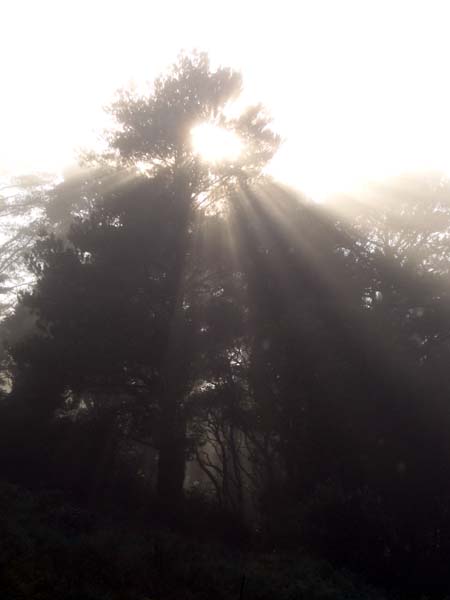 The
view from the
sun/breakfast/dining room at about 7:30 a.m., the morning sun filtering
through one of the Monterey pines on the edge of the gully near the
house.
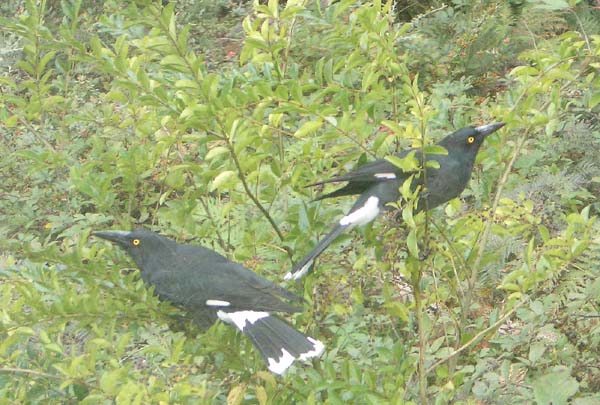 Currawongs harvesting the fall crop in the shrubs just below the window. They're rather raven-like in appearance, but have a range of harmonious calls and whistles that can get almost riotous, especially when a dozen or more of them decide to have a meeting in the eucalypts in the gully. The yellow eyes, like buttons stitched onto their comical heads, distinguish them easily from the even more harmonious, carolling magpies, which have red eyes and grey bills. |
April 8, 2007: An
interesting article in the paper harked back to an earlier Australia,
the "man's world" of rural symbols that is now hanging on by its
toenails as the
nation urbanises and globalises. Apparently it is 50 years since the
recording of the first home-grown Australian gold record, "A Pub With
No Beer," by the greatest of the Aussie country balladeers, Slim
Dusty.
Its refrain, sung to the tune of Stephen Foster's "Beautiful Dreamer,"
states "there's nothing so lonesome, morbid or drear / than to stand in
a bar of a pub with no beer."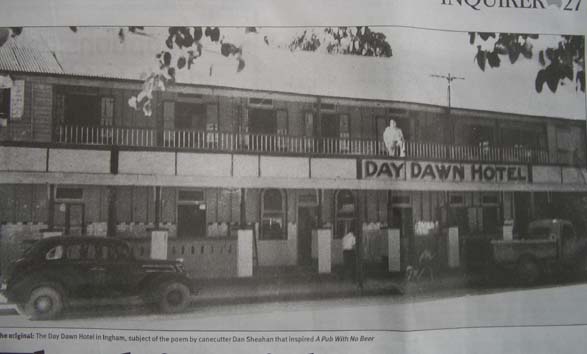 The song comes out of
the Aussie
tradition of the bush ballad, a culture of poetry or verse whose most
famous writers, Banjo Patterson and Henry Lawson, wrote classics like
"The Man from Snowy River" and "Clancy of the Overflow." For example,
at the Blues Festival here in Katoomba a few weeks ago, there were bush
poets reciting to the crowd from the main stage, much like the cowboy
poets at rural fairs in western North America. "A Pub With No Beer"
began as poem by a Queensland canecutter named Dan Sheahan, whose local
pub (the photo above) was drunk dry by US Army servicemen in 1944
during the wartime US "occupation" of Australia that in itself is a
great wellspring of literature and film. With altered lyrics and the
borrowed tune, it became a classic hit.
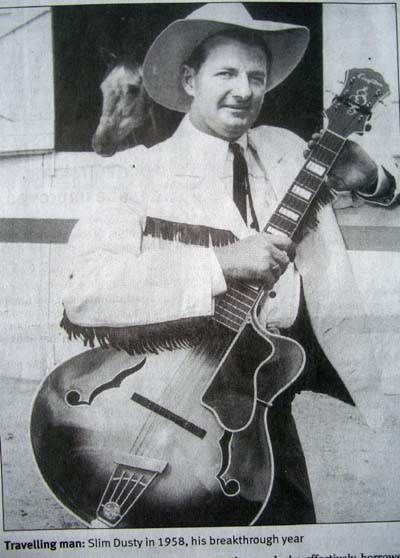 The article reflected
on Slim
Dusty's memorial service in Sydney in 2003, attended by the prime
minister, celebrities and notables, in which the entire congregation
sang the song in unison from memory. The Anglican dean of Sydney
declared that it "was about mateship, the friendship of drinking
together as equals contrasted with the misery of loneliness."
Loudspeakers sent the music into the city streets, "where it elicited a
ripple and a roar," according to journalist Daniel Lewis. "... It
proved again that an overwhelmingly urban and coastal people still look
to the bush for their cultural compass."
I'd never heard of Slim Dusty, but it's interesting how his career parallels that of the first Aussie entertainer to get an international hit, Rolf Harris, whose novelty records came out just a couple of years after "A Pub With No Beer." "Tie Me Kangaroo Down, Sport" was the first, in 1959. But Harris was a clown and his weird songs, especially "My Boomerang Won't Come Back," seem really dated and non-PC (I suggested at a dull family Christmas party here several years ago that everyone sing "Six White Boomers" to try to get into the spirit, but got a hostile response). But then Slim Dusty's world is as non-PC as the White Australia policy that was still in force in the 1950s. Everything about traditional Australia lacks political correctness, but so much of what's happening here now seems indistinguisable from North American or English culture. Which is a mixed blessing, perhaps, or a pity. |
April 7, 2007: Coastal
British Columbians have a right to believe that four beautiful days
will be followed by a long weekend complete with driving rain. So guess
what
happened to Sydney for the Easter weekend?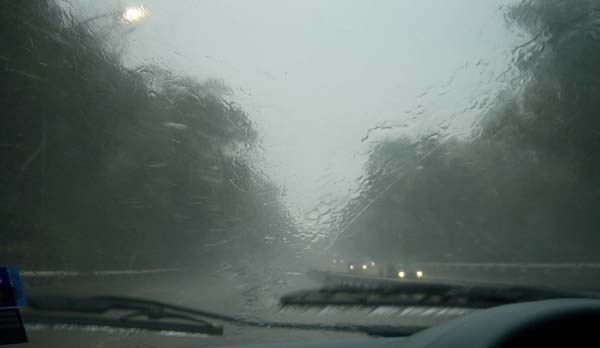 We went into the Big
Smoke
to visit with the rellies and do an overnight cat-sit with Cyrus, Sarah
Jane's kitty, and hit a series of torrential showers that
almost brought cars to a standstill. Any thoughts we had of attending
the big autumn exhibition, the Royal
Easter Show, were put off. Maybe next week. But it was a
perfect time, in
spite of the Easter crowds, to take in the Archibald Prize for Portraiture,
to which I referred back in February, as well as the less-hyped Wynne
Prize for landscape painting and the Sulman Prize for genre painting.
The Archibald, with its celebrity sitters (different from
cat-sitters), attracts most of the
attention, but the paintings for the other prizes were definitely more
varied and interesting. The artists in the Wynne take themselves very
seriously, but many of the entries in the Sulman showed a fine sense of
political satire and humour; the winner was a realistic painting called
Axis of Elvis, showing Richard Nixon meeting The King in front of a
mosque. Go figure. Another painting showed a cartooned, bird's-eye view
of the Baxter Internment Camp, part of the draconian response of the
Howard government to attempted illegal migration. Regrettably,
the pictures don't seem to be
posted on the web.
 On a more prosaic
note, I thought the window display in a chemist in Sydney's inner west
was a real sign of the times. Perhaps this is why so many Sydney men
have shaved heads? Necessity is the mother of fashion?
Back in Katoomba, Easter weekend saw the town chock-a-block full of tourists and visitors. The Climbing Festival was in full swing, as it were, in one part of town, with a tent city set up on vacant land near the shops (and daughter Sarah Jane staying at our place). Down near Katoomba Falls the Christians had a huge revival meeting, but they were less in evidence than the Climbers, other than a man dragging a cross through its stations around the town on Good Friday morning. |
April 3, 2007: Yesterday
was beautiful, sunny and warm, so Roland suggested we go for a drive
late in the afternoon to some of his favorite spots in the
neighbourhood.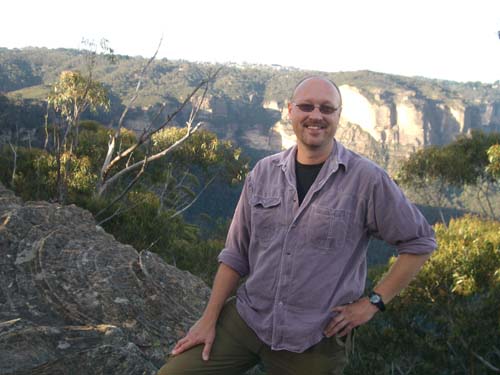 This is Roland
Hemmert who lives
in Flat 2, as he has for the past 7 or so years. An artist -- a
landscape painter, like most Aussies using opaque media, usually oils
but also pastels for sketching -- he's lived in Katoomba since 1995,
and spends his non-painting time working at Megalong Books in Leura,
the adjoining town. He will eventually put up a website -- at least I
hope he will -- for the benefit of those who can't attend his
exhibitions in the Blue Mountains or drop in on him in his studio at
the back of the house with its south light and views over the gum trees
in the gully.
Roland took us out to a few of his favorite painting spots along Narrow Neck, the weird promontory that separates the Jamison Valley from the Megalong. All these places are a 10-15 minute drive from home, but the diversity of landscapes is astonishing. A beautiful afternoon, with the briefest opportunity for me to do a little pencil drawing, and a tantalizing hint of the places and painting opportunities that await once we get the house fixed up and take up exploring. 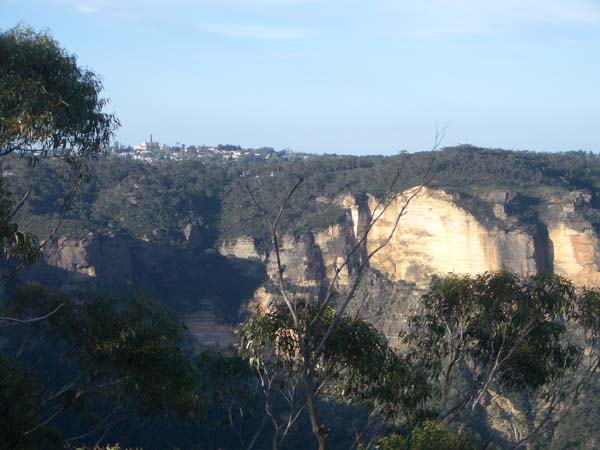 About 4:30 pm, looking back from Narrow Neck to Katoomba with the sheer cliff-face of "Landslide" on the right. The landmark chimney of the Carrington Hotel punctuates the skyline.  By about 5:30 or so we had walked back from the viewpoint above and driven back to the Katoomba end of Narrow Neck, then gone a kilometre or so to Cahill's Lookout, which has views over the Megalong Valley. The sun was dropping toward the distant hills and, through the clouds, shone an orange light onto the sandstone cliffs of Narrow Neck that made them glow blood-red. Hundreds of metres below, a flock of black cockatoos roosted in the trees and cried their mournful calls until the light disappeared a few minutes later. |